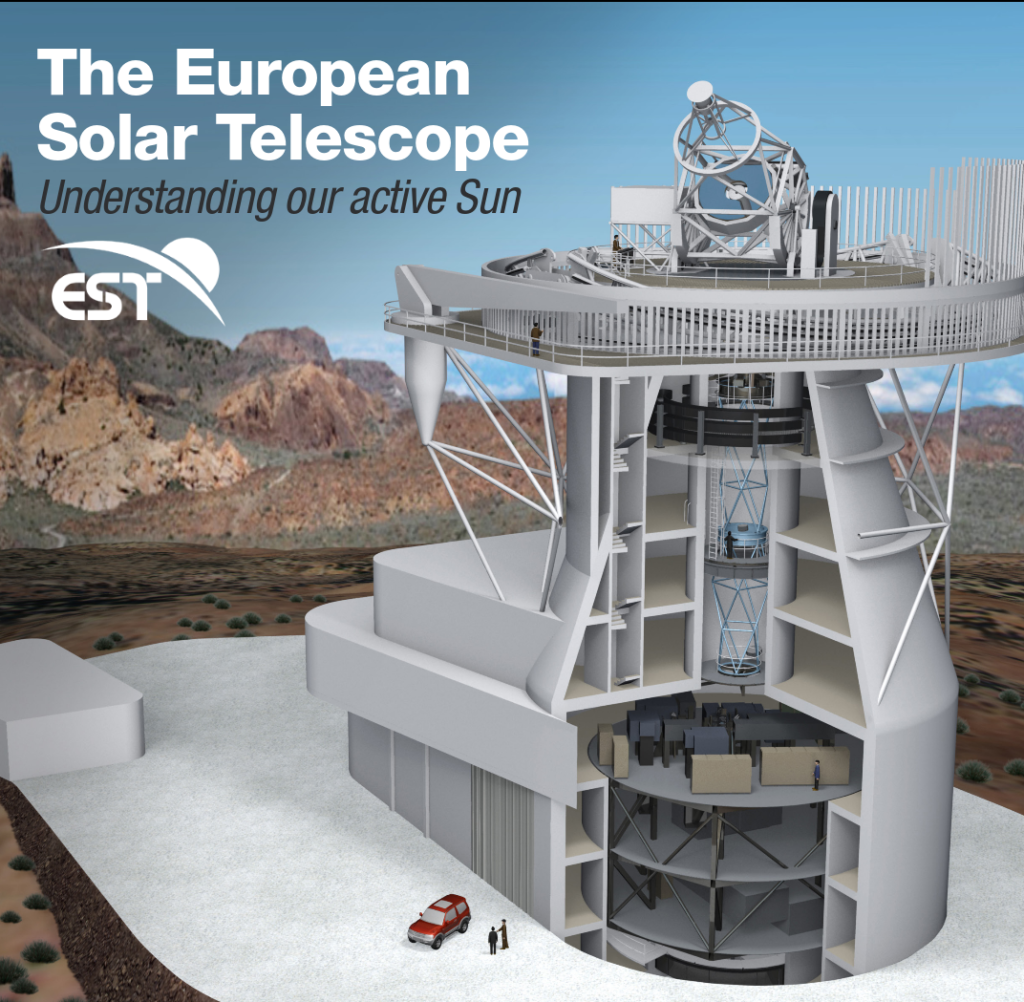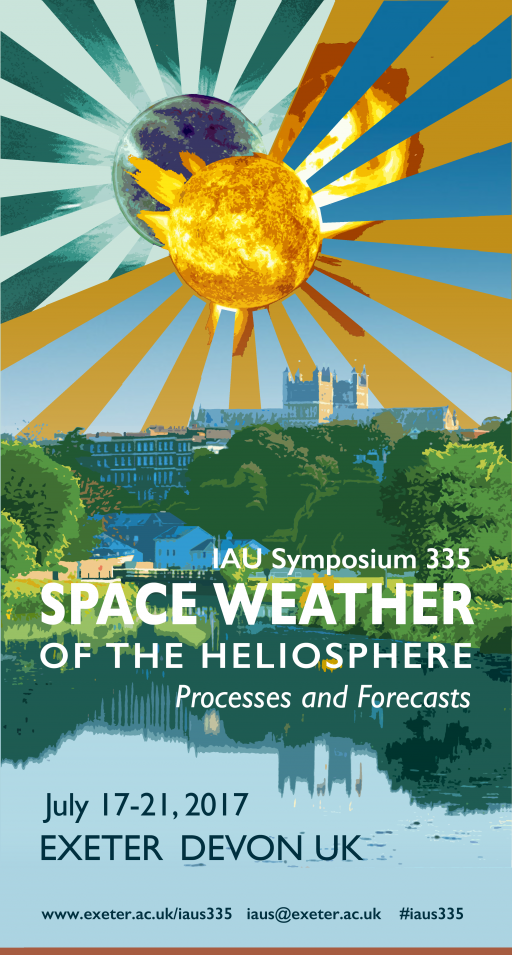Home » 2017
Yearly Archives: 2017
Giornata di presentazione di EST ai Lincei
Con piacere vi informiamo della giornata di presentazione di EST “European Solar Telescope”, che si terrà il prossimo 5 ottobre dalle ore 9.30 presso la Palazzina dell’Auditorium dell’Accademia dei Lincei, Via della Lungara 230, Roma.
piacere vi informiamo della giornata di presentazione di EST “European Solar Telescope”, che si terrà il prossimo 5 ottobre dalle ore 9.30 presso la Palazzina dell’Auditorium dell’Accademia dei Lincei, Via della Lungara 230, Roma.
Questa giornata sarà la prima di una serie di eventi analoghi organizzati nei 15 paesi europei che partecipano alla realizzazione del progetto.
Inserito nel 2016 nella road map di ESFRI come “struttura di ricerca di importanza strategica”, EST sarà il più grande telescopio solare europeo e tra i maggiori al mondo.
Il progetto EST vede coinvolti 21 istituzioni scientifiche ed industriali, di 15 Paesi europei, ed è stato finora finanziato dalla Commissione Europea attraverso progetti dei programmi FP7 e H2020 per un totale di più di 16 milioni di Euro.
La giornata di presentazione vedrà la partecipazione della comunità scientifica italiana ed europea coinvolta nel progetto, dell’eccellenza italiana del settore industriale per l’astrofisica, delle istituzioni e della stampa ed è organizzato, con il supporto dell’Instituto de Astrofisica de Canarias (IAC), dalle istituzioni scientifiche italiane coinvolte in EST: l’Istituto Nazionale di Astrofisica e le Università della Calabria, Catania e Roma “Tor Vergata”.
Seguiranno maggiori dettagli sul programma dell’evento.
Cogliamo l’occasione per porgere cordiali saluti
Il Comitato Scientifico (F. Berrilli, M. Collados, I. Ermolli, F. Lepreti, F. Zuccarello)
Italian contribution at the IAU Symposium 335 “Space Weather of the Heliosphere: Processes and Forecasts”
 On the 17th-21st July 2017, several memebers of SWICO joined the International Astronomical Union Symposium at University of Exeter, UK. The subject of the symposium was “Space Weather of the Heliosphere: Processes and Forecasts” and they presented several projects.
On the 17th-21st July 2017, several memebers of SWICO joined the International Astronomical Union Symposium at University of Exeter, UK. The subject of the symposium was “Space Weather of the Heliosphere: Processes and Forecasts” and they presented several projects.
Among the others, Mauro Messerotti (INAF-OATS) gave an invited talk on “Defining and Characterising Heliospheric Weather and Climate”. The talk was focused on the basic definitions, phenomenology and workflows that lead to monitoring, modelling and predicting both Heliospheric Weather and Heliospheric Climate by pointing out gaps and pitfalls that can affect the development of a robust operational machinery. This requires step forwards in understanding the physics of heliospheric phenomena via long-term, multi-wavelength, and multi-scale observations, still a chimera despite the social benefits it could provide.
Stefania Lepidi, from Italian Istituto Nazionale di Geofisica e Vulcanologia (INGV), presented two posters in the session “Impact of solar wind structures and radiation on magnetospheres”. The first poster deals with the determination of the Earth’s magnetic dip poles using measurements from the Swarm ESA’s constellation of satellites; the second one, in collaboration with the University of L’Aquila, was about the determination of the southern polar cusp location from geomagnetic ground measurements at a pair of Antarctic stations. In both works, the magnetospheric dynamics related to the interaction with the external interplanetary magnetic field was investigated.
Roberta Forte (UTOV) gave a talk in the session “Space weather monitoring, instrumentation, data and services: Future Missions and Instrumentation”. The focus of the talk was the calibration pipeline and the first data analysis results of the MOTH (Magneto-Optical filters at Two Heights) instrument, a dual channel telescope, based on Magneto-Optical Filters (MOFs), that provides full disk line-of-sight Doppler velocity and magnetic field at two levels in the solar atmosphere, useful to investigate atmospheric dynamics and Space Weather phenomena.
Two posters were presented in the same session. A first poster introduced the SWERTO service, an operational Space Weather service that will allow to access scientific data mainly from satellite-borne (e.g.,PAMELA, ALTEA) and ground-based (e.g., IBIS, MOTH II) instruments in which UTOV Space Weather team is involved. A second poster presented the Ionospheric Prediction Service (IPS) project, a collaboration of Telespazio (coordinator), Nottingham Scientific Ltd, Telespazio Vega Deutschland, the University of Nottingham, the University of Rome Tor Vergata and the Italian Institute of Geophysics and Volcanology (INGV), with the aim of designing and developing a prototype platform able to translate the prediction and forecast of the ionosphere effects into a service customized for specific GNSS user communities.
Gianluca Napoletano, from University of L’Aquila, presented a poster in the session “Forecasting Models” about a probabilistic approach to Interplanetary Coronal Mass Ejection Propagation developed using a Drag-Based Model.
International Space Weather Medals Call for Nominations
Dear Colleagues,
We are happy to announce the 2017 contest for the international space weather medals. The new medal recipients will be announced in a medal ceremony at the European Space Weather Week, the 27th of November, 2017.
All three prizes (Chizhevsky, Nicolet, Birkeland) are prestigious recognitions of recipients’ major contributions in the field of space weather. Medal recipient’s work must have been documented in peer review journals or book chapters, or must be a technological contribution that has led to a fully implemented new space weather capability. Medal
recipient’s work must be relevant to space weather and/or space climate. The work must also be internationally recognized.
Please find the necessary information at the URL:
http://www.stce.be/esww14/
We encourage all of you to think about potential nominees.
With Kind Regards,
Mauro Messerotti, on behalf of the SW Medal Committee
NAM 2017: Call for abstracts on “The Physical Processes Underlying Space Weather”
We invite abstract submission for the National Astronomy Meeting 2017 session “The Physical Processes Underlying Space Weather: Formation, Eruption and Propagation of Coronal Mass Ejections”.
The aim of the session is to bring together solar and heliospheric physicists, both modelers and observers, to discuss the formation and evolution of magnetic flux ropes with particular focus on:
- what are the universal physical mechanisms responsible for triggering solar eruptions,
- how and when magnetic flux ropes are formed,
- how their structure evolves during their propagation through the inner heliosphere,
- how the structure of the interplanetary magnetic clouds relate to their source regions on the Sun.
The NAM 2017 will be hosted at the University of Hull (UK) during the 2nd-6th July 2017. We note that this is shortly before the IAU Symposium on Space Weather of the Heliosphere in Exeter (UK), and that this perhaps provides an opportunity for colleagues from further afield to combine two meetings.
Please note that the deadline for abstract submission is April 14, 2017.
For more information, please visit the conference website: https://nam2017.org/
New Topical Issues on SWSC

Dear colleagues,
Three new Topical Issues have just been announced in the Journal of Space Weather and Space Climate. You can find the description at
http://www.swsc-journal.org.
The titles are :
“Developing New Space Weather Tools: Transitioning fundamental science
to operational prediction systems”, deadline: 28 April 2017
“Measurement, Specification and Forecasting of the Solar Energetic
Particle Environment and GLEs”, deadline 30 April 2017
“Flares, coronal mass ejections and solar energetic particles and their
space weather impacts”, deadline 30 April 2017
Do not hesitate to advertise them, or even contribute !
Best regards
Anna and Jean
